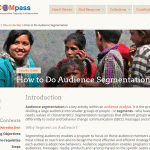Data Offers Deeper Insight into Factors Related to Malaria Behaviors

A child with a bed net in Mosebo Village, Ethiopia. © 2014 Nicole M. Melancon, Courtesy of Photoshare
Health journalists have long known the importance of mobilizing around days that mark specific public health events, such as World Malaria Day, which happens on April 25 this year. In countries where malaria is endemic, malaria is far more than just a disease or statistics. It is a story.
Internews, one of HC3’s specialized partners, has worked with journalists around the world to make the data about the disease personal, and to use the numbers to tell compelling stories about a disease that still claims more than half a million lives yearly. Malaria mortality rates have fallen by 47% globally since 2000, but an alarmingly high number of people still get the disease. The World Health Organization (WHO) estimates released in December 2014 put the number of malaria cases at about 198 million for the previous year (with an uncertainty range of 124 million to 283 million.)[1]
“It is such a solvable problem,” says Ida Jooste, who headed up Internews’ health journalism projects in Kenya for close to a decade and is now the organization’s senior health advisor. She understands the value of digging deep journalistically to tackle the perplexing question of why, in spite of the enormous strides made in controlling the disease, some countries are still far from defeating it entirely.
“Data and statistics are one thing,” Jooste explains. “But it often falls to journalists to make sense of and analyze the numbers in their localized contexts and from a human perspective. In other words, they need to interpret the information and understand that human behavior is a big part of the story. Many journalists in Sub Saharan Africa are writing about a disease that affects them too and they know it is human factors that drive the disease.”
Instrumental in designing Data Dredger, Internews’ data driven and evidence-based journalism project in Kenya, Jooste noted the interesting results that came from journalists mining existing data. For instance, factors such as poor knowledge of the disease and the lack of diagnostic equipment in health facilities were still compromising the fight against malaria in the country. Also, people seem not to take preventive measures seriously, while women were found to not take anti-malarial drugs during pregnancy. And a review of data from 2012 showed that investment levels in the fighting the disease were down; the number of households that owned insecticide treated nets had leveled out, and in the same year, more than 30,000 people died from malaria. You can read more about the Internews project here, and even look at the data that journalists analyzed to write compellingly about a disease that in a perfect world should not be affecting as many people as it does here and here.
Social and behavior change communicators understand the value of using data to gain deeper insight into the human social drivers when it comes to health. The numbers point them to trends and help focus a communications intervention. “The same goes for journalists,” says Jooste. “There is substance in the data, and they point us to stories. These stories come to life through people – and it is the media’s job to help us understand both the significance of numbers and how it impacts people around us.”
HC3 marks World Malaria Day by holding a number of events around the Roll Back Malaria initiative’s campaign theme “Invest in the future: Defeat malaria.”








Leave a Reply
Want to join the discussion?Feel free to contribute!